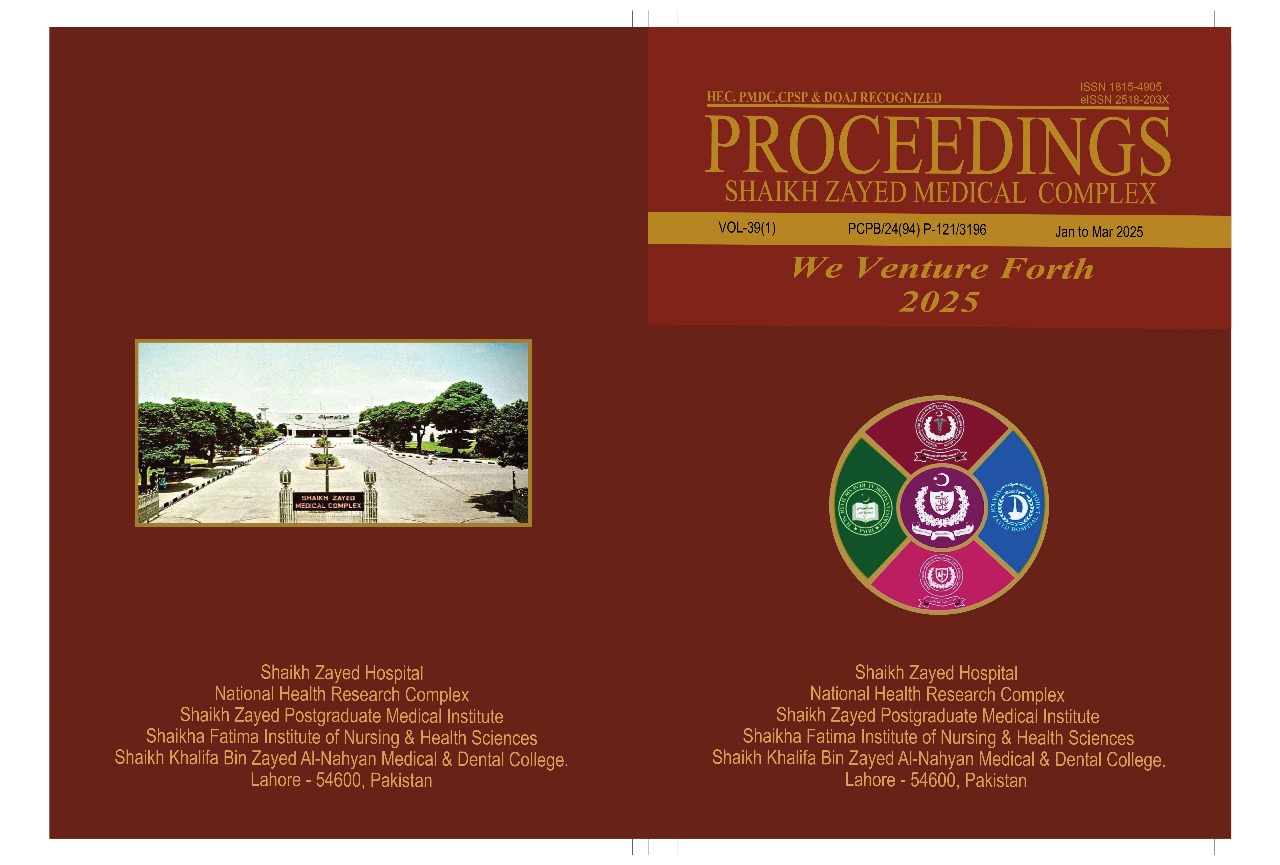Efficacy of Endoscopic Middle-meatus Antrostomy in Chronic Maxillary rhinosinusitis. A Prospective
DOI:
https://doi.org/10.47489/szmc.v39i1.580Keywords:
Endoscopic appearance score, Chronic maxillary sinusitis, Nasal obstruction, Nasal endoscopyAbstract
Introduction: Chronic maxillary sinusitis(CMS) significantly impacts quality of life, requiring effective interventions. Middle meatal antrostomy (MMA) is a widely performed surgical procedure, but its outcomes and complications need further evaluation.
Aims and Objectives: This study aimed to assess the effectiveness of MMA in alleviating symptoms of chronic maxillary sinusitis and identify potential postoperative complications.
Place and Duration of Study: The study was conducted at Khyber Teaching Hospital, Peshawar, from February 2022 to February 2024.
Materials and Methods: A total of 120 consenting patients with chronic maxillary sinusitis meeting inclusion/exclusion criteria participated in this prospective study. Patients underwent clinical examinations, nasal endoscopy, and CT scans pre- and postoperatively. MMA was performed under local or general anesthesia using 0°, 30°, and 70° telescopes, back- biting forceps, and a micro debrider. Postoperative care included removal of nasal packing within 24-48 hours and follow-up assessments at 14 days and 3 months. Pre-and postoperative symptoms were compared, and complications were recorded. Data were analyzed using SPSS version 27. P value less than 0.05 considered significant.
Results: Preoperative symptoms included nasal obstruction (87.5%), facial pain (75.8%), and headaches (63.3%). Postoperatively, nasal obstruction and facial pain decreased to 10.8% and 7.5%, respectively. Persistent headaches were noted in 5.8% of patients who initially reported them, while 71.6% experienced new-onset headaches. Postoperative complications included middle meatal synechiae (14.1%).
Conclusions: MMA significantly alleviated preoperative symptoms of chronic maxillary sinusitis, particularly nasal obstruction, facial pain, and headaches. However, postoperative complications, such as new onset headaches and synechiae, underscore the need for careful patient management and further research to optimize outcomes.
References
Mahasneh SA, Al-Hadidi A, Hassona Y, Sawair FA, Al-Nazer S, Bakain Y, et al. Maxillary sinusitis of odontogenic origin: prevalence among 3d imaging—a retrospective study. Applied Sciences. 2022;12(6):3057.
Kaski HM, Alakärppä A, Lantto U, Laajala A, Tokola P, Penna T, et al. Endoscopic sinus surgery (ESS) to change quality of life for adults with recurrent rhinosinusitis: study protocol for a randomized controlled trial. Trials. 2021;22:1- 12.
Kothiwala SK, Vashisht KR. Draining sinuses and fistulas. Atlas of Clinical Dermatology in Coloured Skin: CRC Press; 2023. p. 331-42.
Bani-Ata M, Aleshawi A, Khatatbeh A, Al- Domaidat D, Alnussair B, Al-Shawaqfeh R, et al. Accessory maxillary ostia: prevalence of an anatomical variant and association with chronic sinusitis. International journal of general medicine. 2020:163-8.
Park W-B, Seol H-K, Shin S, Hong J-Y. Surgical Drainage and Simultaneous Sinus Floor Augmentation in Patients with Chronic Maxillary Sinusitis. Medicina. 2024;60(8):1256.
Rosenfeld RM. Acute sinusitis in adults. New England Journal of Medicine. 2016;375(10):962-70.
Kumar S, Biradar K. Chronic sinusitis: Decoding the triad of epithelial dysfunction, mucosal inflammation, and microbial dynamics. Yemen Journal of Medicine. 2023;2(3):137-44.
Datta N. A Comparative Study of Role of Endoscopic Middle Meatal Antrostomy and Cald-Well-Luc Operation in Treatment of Chronic Maxillary Sinusitis: Rajiv Gandhi University of Health Sciences (India); 2014.
D'Agostino A, Favero V, Nocini R, Venco J, Nocini PF, Trevisiol L. Does middle meatal antrostomy prevent the onset of maxillary sinusitis after zygomatic implant placement? Journal of Oral and Maxillofacial Surgery. 2019;77(12):2475-82.
Acharya S, Panditray S, Prusty N, Dany SS. Middle Meatal Antrostomy inthe Management of Chronic Maxillary Sinusistis.
Kim HJ, Choi JH, Lee JY. Evaluation of recurrent maxillary sinusitis due to middle meatal antrostomy site stenosis. Annals of Otology, Rhinology & Laryngology. 2020;129(10):964-8.
Son WS, Kim YI, Kim SS, Park SB, Kim SH. Anatomical relationship between the maxillary posterior teeth and the sinus floor according to an anterior overbite. Orthodontics & Craniofacial Research. 2020;23(2):160-5.
Themkumkwun S, Kitisubkanchana J, Waikakul A, Boonsiriseth K. Maxillary molar root protrusion into the maxillary sinus: a comparison of cone beam computed tomography and panoramic findings. International journal of oral and maxillofacial surgery. 2019;48(12):1570-6.
Motiwala M, Arif A, Ghafoor R. A CBCT based evaluation of root proximity of maxillary posterior teeth to sinus floor in a subset of Pakistani population. JPMA The Journal of the Pakistan Medical Association. 2021;71(8):1992.
Chan P-S, Sung C-E, Tsai Y-WC, Yuh D-Y, Chen Y-W, Wung H-Y, et al. The relationship between the roots of posterior maxillary teeth and adjacent maxillary sinus floor was associated with maxillary sinus dimension. Journal of Medical Sciences. 2020;40(5):207-14.
Morsy EK, El Dessouky SH, Ghafar EAA. Assessment of proximity of the maxillary premolars roots to the maxillary sinus floor in a sample of Egyptian population using CBCT: An observational cross-sectional study. Journal of International Oral Health. 2022;14(3):306-15.
Kasikcioglu A, Gulsahi A. Relationship between maxillary sinus pathologies and maxillary posterior tooth periapical pathologies. Oral Radiology. 2016;32:180-6.
Shubhasini A, Praveen B, Bhanushree R, Shubha G, Keerthi G. Assessment of the relationship between roots of maxillary first molar to the floor of the maxillary sinus on cone beam computed tomography. Journal of Medicine, Radiology, Pathology and Surgery. 2015;1(4):2-5.
Anupam M, Shailendra G, Prakash S. Study of Surgical Management of Chronic Sinusitis by Middle Meatus Antrostomy and Antral Wash out Procedure. IOSR J. 2019.
Abdulla M, Refaat O, Alahmer M, Yehia A, Abdelsalam H, Abdelaal K, et al. Prelacrimal Recess Approach in Unilateral Maxillary Sinus Lesions: What Is the Impact and Efficacy? Medicina. 2024;60(2):222.
Landsberg R, Warman M, Margulis A, Masalha
M. The rationale for endoscopic inferior meatal antrostomy. ORL. 2019;81(1):41-7.
Lin YT, Lin CF, Yeh TH, editors. Application of the endoscopic prelacrimal recess approach to the maxillary sinus in unilateral maxillary diseases. International Forum of Allergy & Rhinology; 2018: Wiley Online Library.
Downloads
Published
How to Cite
Issue
Section
License
Copyright (c) 2025 Proceedings

This work is licensed under a Creative Commons Attribution 4.0 International License.


 This work is licensed under a
This work is licensed under a 